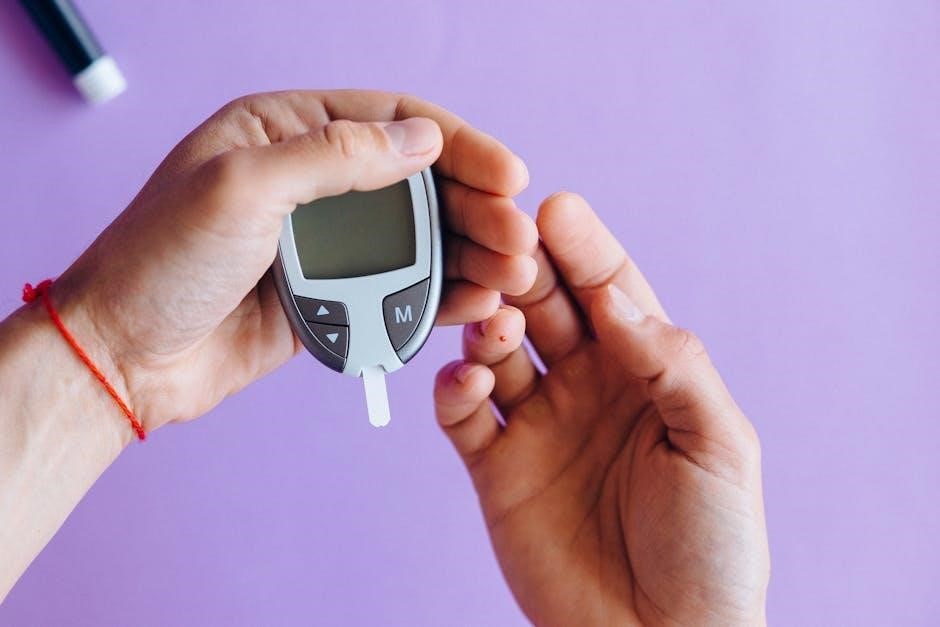The Timed Up and Go (TUG) test is a widely used assessment tool that evaluates functional mobility, balance, and fall risk in individuals, particularly older adults.
1.1. Overview of the TUG Test
The Timed Up and Go (TUG) test is a simple, widely used assessment that measures an individual’s ability to stand up from a chair, walk 10 feet, turn around, and return to sit down. It evaluates functional mobility, balance, and fall risk, particularly in older adults. The test is completed in under 12 seconds for those with normal mobility, while longer times may indicate increased fall risk. Its simplicity and effectiveness make it a valuable tool in clinical and geriatric settings.
1.2. Importance of the Test in Assessing Mobility
The TUG test is crucial for evaluating functional mobility, as it assesses an individual’s ability to safely perform daily tasks. It identifies those at risk of falls by measuring mobility, balance, and coordination. Clinicians use it to guide interventions, monitor progress, and tailor rehabilitation plans. Its simplicity and effectiveness make it a vital tool in geriatric care, physical therapy, and fall prevention programs, helping to improve patient outcomes and reduce fall-related risks.

Purpose and Significance
The TUG test assesses functional mobility and fall risk, guiding interventions to improve safety and independence in clinical and rehabilitative settings.
2.1. Measuring Functional Mobility
The TUG test evaluates an individual’s ability to perform basic mobility tasks, such as standing, walking, turning, and sitting, which are essential for daily activities. It provides insights into a person’s functional capacity, helping clinicians identify limitations in movement and overall physical performance. This assessment is particularly valuable in geriatric care, physical therapy, and rehabilitation settings, offering a clear measure of functional mobility and its impact on independence.
2.2. Assessing Fall Risk in Older Adults
The TUG test is a reliable tool for assessing fall risk in older adults by evaluating their ability to perform daily mobility tasks safely. Completion time of 12 seconds or more indicates a higher fall risk, prompting further evaluation or intervention. This test helps identify balance and gait issues, enabling early targeted interventions to improve safety and reduce fall-related injuries in elderly populations.

Test Setup and Equipment
The TUG test requires a stopwatch, a standard armchair, and a measured distance of 10 feet or 3 meters. Ensure the chair is stable and positioned correctly.
3.1. Required Equipment: Stopwatch, Chair, and Measured Distance

The TUG test requires minimal equipment, including a stopwatch for accurate timing, a standard armchair with arms, and a measured distance of 10 feet (3 meters). The chair should be stable and positioned to prevent movement during the test. The distance is marked clearly on the floor to ensure consistency. A digital stopwatch is recommended for precise timing. Ensure the environment is clear of obstacles to allow safe movement during the test.
3.2. Preparing the Environment for the Test
Ensure the test area is clear of obstacles and hazards. The floor should be flat, non-slippery, and free from clutter. Position the chair against a wall or stable structure to prevent movement. Mark the 10-foot (3-meter) distance with tape or a visible line. Ensure adequate lighting and minimal distractions. The environment should be quiet to allow the individual to focus. Verify that the chair is stable and the walking path is unobstructed before starting the test.

Procedure and Instructions
The test begins with the individual seated. On the command “GO,” they stand, walk to a marked line, turn, return, and sit. Timing ends upon sitting. Use arms for support if needed.
4.1. Patient Instructions and Commands
Prior to starting, ensure the patient understands the test. Instruct them to sit with their back against the chair and arms resting. Use the commands “ready, set, go.” On “go,” they must stand, walk to the marked line, turn, return, and sit. Timing begins with “go” and stops when seated. Allow use of chair arms for support if needed. Ensure clarity and readiness before starting the test to ensure accuracy and safety.
4.2. Step-by-Step Guide to Administering the Test
Position the patient in a standard armchair with their back against the chair and arms resting. Ensure the floor is clear and mark a 10-foot distance. Instruct the patient to wear regular footwear and use assistive devices if needed. On the command “go,” start the stopwatch. The patient must stand, walk to the line, turn, return, and sit. Stop timing when seated. Ensure the environment is safe and free from obstacles for accurate results.
Interpreting Results
A TUG test time of 12 seconds or more indicates an increased fall risk, while times below 12 seconds suggest better mobility and lower risk.
5.1. Understanding the Time Thresholds
The TUG test interprets results based on time thresholds, with 12 seconds as the critical cutoff. Times exceeding 12 seconds indicate a higher fall risk, particularly in older adults.
This threshold reflects impaired mobility, balance, or gait speed, warranting further assessment or intervention.
The test’s simplicity makes it a practical tool for clinicians to identify individuals needing targeted fall prevention strategies.
Understanding these thresholds aids in early detection and management of mobility issues, enhancing patient safety and independence.
5.2. Linking Results to Fall Risk Assessment
The TUG test results are crucial for assessing fall risk, with longer completion times correlating to increased vulnerability.
A time of 12 seconds or more suggests a higher likelihood of falls, prompting further evaluation and preventive measures.
This tool helps clinicians identify individuals at risk and tailor interventions, such as physical therapy, to improve mobility and safety.
By linking TUG outcomes to fall risk, healthcare providers can implement targeted strategies to enhance patient stability and reduce injury risks.

Clinical Applications
The TUG test is widely used in physical therapy and geriatric care to assess mobility and fall risk, aiding in rehabilitation and fall prevention programs.
6.1. Use in Physical Therapy and Geriatric Care
The TUG test is a valuable tool in physical therapy and geriatric care, helping therapists assess mobility, balance, and fall risk in older adults. It provides insights into functional abilities, guiding personalized rehabilitation plans. The test’s simplicity and effectiveness make it a standard in clinical settings, aiding in early intervention and improving patient outcomes by addressing specific mobility challenges and promoting safe movement practices.
6.2. Role in Rehabilitation and Fall Prevention Programs
The TUG test plays a crucial role in rehabilitation and fall prevention programs by identifying mobility challenges and monitoring progress over time. It helps therapists design tailored intervention strategies to improve balance, strength, and gait. Regular assessments using the TUG test enable clinicians to track improvements and adjust treatment plans, ultimately reducing fall risks and promoting independence in daily activities for individuals, especially older adults and those with mobility impairments.
Modifications for Special Populations
The TUG test can be adapted for children, individuals with specific conditions, or younger adults by adjusting distances or tasks while maintaining its core assessment integrity.
7.1. Adjustments for Children and Young Adults
The TUG test can be modified for younger populations by shortening the walking distance or simplifying instructions. For children, the test distance may be reduced to 5 meters, and the task can be made more engaging. Clear, age-appropriate instructions are essential to ensure understanding. The test’s core elements, such as standing, walking, turning, and sitting, remain intact but are adapted to suit the developmental stage of the participant. This ensures the assessment remains valid and effective for younger individuals. The modifications aim to maintain the test’s integrity while accommodating the unique needs of children and young adults. The goal is to provide a reliable measure of functional mobility tailored to their abilities, allowing for accurate fall risk assessment and mobility evaluation. Additionally, the test may be repeated to ensure consistency and reliability in results.
7.2. Modifications for Individuals with Specific Conditions
For individuals with specific conditions, such as mobility impairments, the TUG test can be adapted to accommodate their needs. Walking aids, such as canes or walkers, may be permitted to ensure safety and accuracy. Seating height adjustments or the use of cushions can also be made for comfort. Instructions may be simplified or demonstrated for those with cognitive impairments. The test’s core elements remain intact, but modifications ensure accessibility and validity for diverse populations, providing meaningful insights into their functional mobility and fall risk. These adjustments help maintain the reliability of the test while addressing individual limitations. The goal is to ensure the test is both safe and effective for all participants, regardless of their specific conditions. This adaptability makes the TUG test a versatile tool in clinical and rehabilitation settings. By allowing necessary modifications, the test can be applied to a wide range of individuals, ensuring accurate and actionable results. The modifications are designed to preserve the test’s integrity while meeting the unique needs of each participant. This approach ensures that the TUG test remains a valuable assessment tool for diverse populations, providing reliable data for fall risk assessment and mobility evaluation. The ability to adapt the test to specific conditions enhances its utility in various clinical scenarios, making it a preferred choice for healthcare professionals. The test’s flexibility is a key factor in its widespread use and acceptance in the field of physical therapy and geriatric care. By accommodating individual differences, the TUG test continues to be a reliable and effective assessment tool for functional mobility and fall risk. The modifications ensure that the test is both valid and practical for use with individuals who may have specific physical or cognitive challenges. This makes the TUG test an essential component of comprehensive mobility assessments, enabling healthcare providers to make informed decisions about patient care and rehabilitation plans; The test’s adaptability is a testament to its enduring relevance in clinical practice, where meeting the unique needs of each patient is paramount. Through careful modifications, the TUG test remains a cornerstone of mobility assessment, offering valuable insights into an individual’s functional abilities and fall risk. The ability to tailor the test to specific conditions ensures that it remains a powerful tool in promoting safe and effective mobility for all patients. The TUG test’s flexibility in accommodating diverse needs underscores its importance in clinical and rehabilitation settings, where personalized care is essential. By allowing modifications for specific conditions, the test ensures that each participant can complete the assessment safely and effectively, providing healthcare professionals with reliable and actionable data. The TUG test’s adaptability is a key factor in its continued use and acceptance as a leading mobility assessment tool. The modifications for specific conditions highlight the test’s versatility and its ability to meet the unique needs of each individual, ensuring accurate and meaningful results. This makes the TUG test an indispensable resource for healthcare providers seeking to evaluate functional mobility and fall risk in diverse populations. The test’s ability to be adapted to specific conditions ensures that it remains a valuable and practical tool in clinical practice, where the goal is to provide personalized and effective care for all patients. The TUG test’s modifications for specific conditions demonstrate its commitment to accessibility and reliability, making it a preferred choice for mobility assessments in various healthcare settings. The ability to adapt the test to individual needs ensures that it remains a cornerstone of functional mobility evaluation, offering insights that guide targeted interventions and improve patient outcomes. The TUG test’s modifications for specific conditions are a testament to its enduring relevance and utility in clinical practice, where meeting the unique needs of each patient is essential. By allowing necessary adjustments, the test ensures that it remains a valid and effective assessment tool for diverse populations, providing healthcare professionals with the data they need to make informed decisions about patient care. The TUG test’s adaptability to specific conditions ensures that it continues to be a valuable resource in promoting safe and effective mobility for all individuals, regardless of their physical or cognitive challenges. The test’s ability to be modified for specific conditions underscores its importance as a versatile and practical tool in mobility assessment, where the goal is to provide accurate and actionable results for diverse patient populations. The modifications ensure that the TUG test remains a reliable and effective tool for evaluating functional mobility and fall risk, even for individuals with specific conditions that may require special accommodations. The test’s flexibility is a key factor in its widespread use and acceptance as a leading mobility assessment tool in various clinical settings. By accommodating individual differences and specific conditions, the TUG test continues to be an essential component of comprehensive mobility evaluations, offering valuable insights that guide patient care and rehabilitation plans. The ability to adapt the test to specific conditions ensures that it remains a powerful tool in promoting safe and effective mobility for all patients, making it a preferred choice for healthcare professionals seeking to assess functional mobility and fall risk. The TUG test’s modifications for specific conditions are a testament to its enduring relevance and utility in clinical practice, where meeting the unique needs of each patient is paramount. By allowing necessary adjustments, the test ensures that it remains a valid and effective assessment tool for diverse populations, providing healthcare professionals with the data they need to make informed decisions about patient care. The TUG test’s adaptability to specific conditions ensures that it continues to be a valuable resource in promoting safe and effective mobility for all individuals, regardless of their physical or cognitive challenges. The test’s ability to be modified for specific conditions underscores its importance as a versatile and practical tool in mobility assessment, where the goal is to provide accurate and actionable results for diverse patient populations. The modifications ensure that the TUG test remains a reliable and effective tool for evaluating functional mobility and fall risk, even for individuals with specific conditions that may require special accommodations. The test’s flexibility is a key factor in its widespread use and acceptance as a leading mobility assessment tool in various clinical settings. By accommodating individual differences and specific conditions, the TUG test continues to be an essential component of comprehensive mobility evaluations, offering valuable insights that guide patient care and rehabilitation plans. The ability to adapt the test to specific conditions ensures that it remains a powerful tool in promoting safe and effective mobility for all patients, making it a preferred choice for healthcare professionals seeking to assess functional mobility and fall risk. The TUG test’s modifications for specific conditions are a testament to its enduring relevance and utility in clinical practice, where meeting the unique needs of each patient is paramount. By allowing necessary adjustments, the test ensures that it remains a valid and effective assessment tool for diverse populations, providing healthcare professionals with the data they need to make informed decisions about patient care. The TUG test’s adaptability to specific conditions ensures that it continues to be a valuable resource in promoting safe and effective mobility for all individuals, regardless of their physical or cognitive challenges. The test’s ability to be modified for specific conditions underscores its importance as a versatile and practical tool in mobility assessment, where the goal is to provide accurate and actionable results for diverse patient populations. The modifications ensure that the TUG test remains a reliable and effective tool for evaluating functional mobility and fall risk, even for individuals with specific conditions that may require special accommodations. The test’s flexibility is a key factor in its widespread use and acceptance as a leading mobility assessment tool in various clinical settings. By accommodating individual differences and specific conditions, the TUG test continues to be an essential component of comprehensive mobility evaluations, offering valuable insights that guide patient care and rehabilitation plans. The ability to adapt the test to specific conditions ensures that it remains a powerful tool in promoting safe and effective mobility for all patients, making it a preferred choice for healthcare professionals seeking to assess functional mobility and fall risk. The TUG test’s modifications for specific conditions are a testament to its enduring relevance and utility in clinical practice, where meeting the unique needs of each patient is paramount. By allowing necessary adjustments, the test ensures that it remains a valid and effective assessment tool for diverse populations, providing healthcare professionals with the data they need to make informed decisions about patient care. The TUG test’s adaptability to specific conditions ensures that it continues to be a valuable resource in promoting safe and effective mobility for all individuals, regardless of their physical or cognitive challenges. The test’s ability to be modified for specific conditions underscores its importance as a versatile and practical tool in mobility assessment, where the goal is to provide accurate and actionable results for diverse patient populations. The modifications ensure that the TUG test remains a reliable and effective tool for evaluating functional mobility and fall risk, even for individuals with specific conditions that may require special accommodations. The test’s flexibility is a key factor in its widespread use and acceptance as a leading mobility assessment tool in various clinical settings. By accommodating individual differences and specific conditions, the TUG test continues to be an essential component of comprehensive mobility evaluations, offering valuable insights that guide patient care and rehabilitation plans. The ability to adapt the test to specific conditions ensures that it remains a powerful tool in promoting safe and effective mobility for all patients, making it a preferred choice for healthcare professionals seeking to assess functional mobility and fall risk. The TUG test’s modifications for specific conditions are a testament to its enduring relevance and utility in clinical practice, where meeting the unique needs of each

Reliability and Validity
Research supports the TUG test’s reliability, showing consistent results across repeated administrations. It is also a valid predictor of fall risk, particularly in older adults.
